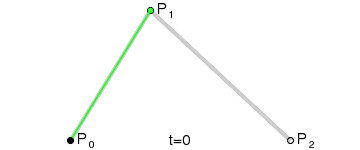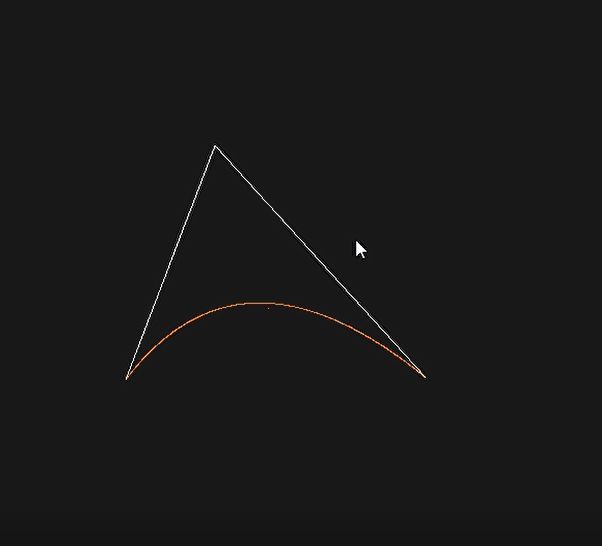计算机图形学作业( 七):利用 OpenGL 绘制 Bezier 贝塞尔曲线
计算机图形学作业( 七):利用 OpenGL 绘制 Bezier 贝塞尔曲线
- Bezier 曲线原理
- OpenGL 实现思路
- 捕获鼠标点击时的坐标
- 根据顶点画出连续的线段
- 根据顶点画出 Bezier 贝塞尔曲线
- 效果
- 代码
Bezier 曲线原理
Bezier 曲线的原理我参考了这篇博客:https://www.cnblogs.com/hyb1/p/3875468.html。
Bezier 曲线是应用于二维图形的曲线。曲线由顶点和控制点组成,通过改变控制点坐标可以改变曲线的形状。
一次 Bezier 曲线公式:
一次 Bezier 曲线是由 P0 至 P1 的连续点,描述的一条线段。
二次 Bezier 曲线公式:
二次 Bezier 曲线是 P0 至 P1 的连续点 Q0 和 P1 至 P2 的连续点 Q1 组成的线段上的连续点 B(t),描述一条抛物线。
三次 Bezier 曲线公式:
由此可得 Bezier 曲线的一般方程为:
OpenGL 实现思路
在 OpenGL 窗口中,我们希望能通过左键点击窗口添加 Bezier 曲线的控制点,右键点击则对当前添加的最后一个控制点进行消除。然后根据鼠标绘制的控制点实时更新 Bezier 曲线。
捕获鼠标点击时的坐标
我们需要用一个回调函数,该函数是在鼠标移动时不断获取鼠标在窗口的坐标。
首先我们要声明全局的鼠标位置变量,代码如下:
float mouseXPos, mouseYPos;
然后在鼠标事件中不断更新全局位置变量的值。代码如下
void cursor_position_callback(GLFWwindow* window, double x, double y) {
mouseXPos = float((x - WINDOW_WIDTH / 2) / WINDOW_WIDTH) * 2;
mouseYPos = float(0 - (y - WINDOW_HEIGHT / 2) / WINDOW_HEIGHT) * 2;
return;
}
根据顶点画出连续的线段
前面我们获取的鼠标的当前位置,那么当鼠标点击左键时,我们要捕获该点击事件,将顶点数据添加到 lineVertices 并通过绑定 VAO 画出线段。
先声明全局的顶点数据变量:
// 声明全局顶点变量, 点个数为 vertexLen / 3
int lineVertexLen = 0;
float lineVertices[MAX_VERTEX_LEN] = {
//位置
//-0.5f, 0.5f, 0.0f
};
然后再鼠标点击事件中操作:
void mouse_button_callback(GLFWwindow* window, int button, int action, int mods) {
if (action == GLFW_PRESS) switch (button) {
case GLFW_MOUSE_BUTTON_LEFT:
// 每隔两个点画一条直线
// 鼠标点击的点
lineVertices[lineVertexLen] = mouseXPos;
lineVertexLen++;
lineVertices[lineVertexLen] = mouseYPos;
lineVertexLen++;
lineVertices[lineVertexLen] = 0.0f;
lineVertexLen++;
// 添加索引,前一个点也新的点一起确定新线段
if (lineIndicesLen >= 2) {
lineIndices[lineIndicesLen] = lineIndices[lineIndicesLen - 1];
lineIndicesLen++;
lineIndices[lineIndicesLen] = lineIndices[lineIndicesLen - 1] + 1;
lineIndicesLen++;
}
else {
lineIndices[lineIndicesLen] = lineIndicesLen;
lineIndicesLen++;
}
break;
default:
break;
}
return;
}
之后便是通过 VAO、VBO 和 GL_LINES 等画出线段。
根据顶点画出 Bezier 贝塞尔曲线
根据之前的 Bezier 曲线一般式,我们能很容易地根据顶点计算出 Bezier 曲线的点数据。只要新声明一个函数,传入顶点的数据和长度,就能计算出各个位置上的 Bezier 曲线的点数据,如下:
int getBezierVertex(float lineVertices[MAX_VERTEX_LEN], int lineVertexLen, float bezierVertices[MAX_BEZIER_VERTEX_LEN]) {
int bezierVertexLen = 0;
if (lineVertexLen == 0) return bezierVertexLen;
else if (lineVertexLen == 3) {
bezierVertices[bezierVertexLen] = lineVertices[0];
bezierVertexLen++;
bezierVertices[bezierVertexLen] = lineVertices[1];
bezierVertexLen++;
bezierVertices[bezierVertexLen] = lineVertices[2];
bezierVertexLen++;
}
else {
for (float t = 0.000f; t <= 1.000f; t = t + 0.001f) {
double new_xPos = 0, new_yPos = 0;
for (int index = 0; index < lineVertexLen / 3; index++) {
// x坐标
new_xPos += lineVertices[index * 3] * pow(t, index) * pow((1 - t), (lineVertexLen / 3 - 1 - index));
// y坐标
new_yPos += lineVertices[index * 3 + 1] * pow(t, index) * pow((1 - t), (lineVertexLen / 3 - 1 - index));
}
bezierVertices[bezierVertexLen] = new_xPos;
bezierVertexLen++;
bezierVertices[bezierVertexLen] = new_yPos;
bezierVertexLen++;
bezierVertices[bezierVertexLen] = 0.0f;
bezierVertexLen++;
}
}
return bezierVertexLen;
}
之后便可以通过 VAO、VBO 和 GL_POINTS 等画出 Bezier 曲线。
效果
代码
#include
#include
#include
#include
#include "imgui.h"
#include "imgui_impl_glfw.h"
#include "imgui_impl_opengl3.h"
#include
#include
#include
// 加载纹理的库
#include "stb_image.h"
//使用了官方的shader库文件,可以更方便地操作shader
//注意,使用官方库操作shadder时,自己写的顶点和片段着色器代码必须另外写成文件
//然后把文件路径传入shader.h提供的构造函数
#include "shader.h"
using namespace std;
const int WINDOW_WIDTH = 1000;
const int WINDOW_HEIGHT = 800;
const int MAX_VERTEX_LEN = 300;
const int MAX_INDICES_LEN = 600;
const int MAX_BEZIER_VERTEX_LEN = 3000;
void framebuffer_size_callback(GLFWwindow* window, int width, int height);
void processInput(GLFWwindow* window);
void mouse_button_callback(GLFWwindow* window, int button, int action, int mods);
void cursor_position_callback(GLFWwindow* window, double x, double y);
int getBezierVertex(float lineVertices[MAX_VERTEX_LEN],int lineVertexLen, float bezierVertices[MAX_BEZIER_VERTEX_LEN]);
// 声明鼠标全局位置变量
float mouseXPos, mouseYPos;
// 声明全局顶点变量, 点个数为 vertexLen / 3
int lineVertexLen = 0;
float lineVertices[MAX_VERTEX_LEN] = {
//位置
//-0.5f, 0.5f, 0.0f,
//0.5f, 0.5f, 0.0f,
//0.5f, -0.5f, 0.0f
};
int lineIndicesLen = 0;
unsigned int lineIndices[MAX_INDICES_LEN] = { // 注意索引从0开始!
//0, 1, // 第一个线段
//1, 2
};
int main() {
//初始化opengl窗口和配置
glfwInit();
glfwWindowHint(GLFW_CONTEXT_VERSION_MAJOR, 3);
glfwWindowHint(GLFW_CONTEXT_VERSION_MINOR, 3);
glfwWindowHint(GLFW_OPENGL_PROFILE, GLFW_OPENGL_CORE_PROFILE);
GLFWwindow* window = glfwCreateWindow(WINDOW_WIDTH, WINDOW_HEIGHT, "LearnOpenGL", NULL, NULL);
if (window == NULL) {
std::cout << "Failed to create GLFW window" << std::endl;
glfwTerminate();
return -1;
}
glfwMakeContextCurrent(window);
glfwSetFramebufferSizeCallback(window, framebuffer_size_callback);
glfwSetMouseButtonCallback(window, mouse_button_callback);
glfwSetCursorPosCallback(window, cursor_position_callback);
if (!gladLoadGLLoader((GLADloadproc)glfwGetProcAddress)) {
std::cout << "Failed to initialize GLAD" << std::endl;
return -1;
}
// 深度测试
glEnable(GL_DEPTH_TEST);
//创建并绑定ImGui
const char* glsl_version = "#version 130";
IMGUI_CHECKVERSION();
ImGui::CreateContext();
ImGuiIO& io = ImGui::GetIO(); (void)io;
ImGui::StyleColorsDark();
ImGui_ImplGlfw_InitForOpenGL(window, true);
ImGui_ImplOpenGL3_Init(glsl_version);
Shader lineShader("vertexShader.vs", "lineFragmentShader.fs");
Shader bezierShader("vertexShader.vs", "bezierFragmentShader.fs");
bool show_window = true;
while (!glfwWindowShouldClose(window)) {
processInput(window);
//清除屏幕
glClearColor(0.1f, 0.1f, 0.1f, 1.0f);
glClear(GL_COLOR_BUFFER_BIT | GL_DEPTH_BUFFER_BIT);
unsigned int VAO;
unsigned int VBO;
unsigned int EBO;
//必须先绑定VA0
glGenVertexArrays(1, &VAO);
glBindVertexArray(VAO);
//再绑定VBO
glGenBuffers(1, &VBO);
glBindBuffer(GL_ARRAY_BUFFER, VBO);
glBufferData(GL_ARRAY_BUFFER, sizeof(lineVertices), lineVertices, GL_STATIC_DRAW);
//使用EBO画多个线段,组合成其它图形
glGenBuffers(1, &EBO);
glBindBuffer(GL_ELEMENT_ARRAY_BUFFER, EBO);
glBufferData(GL_ELEMENT_ARRAY_BUFFER, sizeof(lineIndices), lineIndices, GL_STATIC_DRAW);
//再设置属性
//位置属性
//属性位置值为0的顶点属性
glVertexAttribPointer(0, 3, GL_FLOAT, GL_FALSE, 3 * sizeof(float), (void*)0);
glEnableVertexAttribArray(0);
glBindBuffer(GL_ARRAY_BUFFER, 0);
glEnableVertexAttribArray(1);
// 使用着色器程序
lineShader.use();
//画线段,
glBindVertexArray(VAO);
// 因为通过 indices 确定线段,每两点确定一线段,所以画多少线段,就填入线段数乘以2
if (lineIndicesLen >= 2) {
glDrawElements(GL_LINES, lineIndicesLen, GL_UNSIGNED_INT, 0);
}
// 以下是 bezier 点数据
// 声明 bezier 顶点变量
int bezierVertexLen = 0;
float bezierVertices[MAX_BEZIER_VERTEX_LEN] = {
//-0.5f, 0.5f, 0.0f,
};
bezierVertexLen = getBezierVertex(lineVertices, lineVertexLen, bezierVertices);
unsigned int bezierVAO;
unsigned int bezierVBO;
//必须先绑定VA0
glGenVertexArrays(1, &bezierVAO);
glBindVertexArray(bezierVAO);
//再绑定VBO
glGenBuffers(1, &bezierVBO);
glBindBuffer(GL_ARRAY_BUFFER, bezierVBO);
glBufferData(GL_ARRAY_BUFFER, sizeof(bezierVertices), bezierVertices, GL_STATIC_DRAW);
//再设置属性
//位置属性
//属性位置值为0的顶点属性
glVertexAttribPointer(0, 3, GL_FLOAT, GL_FALSE, 3 * sizeof(float), (void*)0);
glEnableVertexAttribArray(0);
glBindBuffer(GL_ARRAY_BUFFER, 0);
glEnableVertexAttribArray(1);
// 使用着色器程序
bezierShader.use();
//画线段,
glBindVertexArray(bezierVAO);
glDrawArrays(GL_POINTS, 0, bezierVertexLen / 3);
//创建imgui
ImGui_ImplOpenGL3_NewFrame();
ImGui_ImplGlfw_NewFrame();
ImGui::NewFrame();
ImGui::Begin("Edit cube", &show_window, ImGuiWindowFlags_MenuBar);
ImGui::End();
ImGui::Render();
int display_w, display_h;
glfwMakeContextCurrent(window);
glfwGetFramebufferSize(window, &display_w, &display_h);
glViewport(0, 0, display_w, display_h);
ImGui_ImplOpenGL3_RenderDrawData(ImGui::GetDrawData());
glfwPollEvents();
glfwSwapBuffers(window);
}
glfwTerminate();
return 0;
}
void framebuffer_size_callback(GLFWwindow* window, int width, int height) {
glViewport(0, 0, width, height);
}
void processInput(GLFWwindow* window) {
if (glfwGetKey(window, GLFW_KEY_ESCAPE) == GLFW_PRESS) {
glfwSetWindowShouldClose(window, true);
}
}
void mouse_button_callback(GLFWwindow* window, int button, int action, int mods) {
if (action == GLFW_PRESS) switch (button) {
case GLFW_MOUSE_BUTTON_LEFT:
// 每隔两个点画一条直线
// 鼠标点击的点
lineVertices[lineVertexLen] = mouseXPos;
lineVertexLen++;
lineVertices[lineVertexLen] = mouseYPos;
lineVertexLen++;
lineVertices[lineVertexLen] = 0.0f;
lineVertexLen++;
// 添加索引,前一个点也新的点一起确定新线段
if (lineIndicesLen >= 2) {
lineIndices[lineIndicesLen] = lineIndices[lineIndicesLen - 1];
lineIndicesLen++;
lineIndices[lineIndicesLen] = lineIndices[lineIndicesLen - 1] + 1;
lineIndicesLen++;
}
else {
lineIndices[lineIndicesLen] = lineIndicesLen;
lineIndicesLen++;
}
break;
case GLFW_MOUSE_BUTTON_RIGHT:
if (lineVertexLen >= 3) {
lineVertexLen = lineVertexLen - 3;
}
if (lineIndicesLen >= 4) {
lineIndicesLen = lineIndicesLen - 2;
}
else {
lineIndicesLen = lineIndicesLen - 1;
}
break;
default:
break;
}
return;
}
void cursor_position_callback(GLFWwindow* window, double x, double y) {
mouseXPos = float((x - WINDOW_WIDTH / 2) / WINDOW_WIDTH) * 2;
mouseYPos = float(0 - (y - WINDOW_HEIGHT / 2) / WINDOW_HEIGHT) * 2;
return;
}
int getBezierVertex(float lineVertices[MAX_VERTEX_LEN], int lineVertexLen, float bezierVertices[MAX_BEZIER_VERTEX_LEN]) {
int bezierVertexLen = 0;
if (lineVertexLen == 0) return bezierVertexLen;
else if (lineVertexLen == 3) {
bezierVertices[bezierVertexLen] = lineVertices[0];
bezierVertexLen++;
bezierVertices[bezierVertexLen] = lineVertices[1];
bezierVertexLen++;
bezierVertices[bezierVertexLen] = lineVertices[2];
bezierVertexLen++;
}
else {
for (float t = 0.000f; t <= 1.000f; t = t + 0.001f) {
double new_xPos = 0, new_yPos = 0;
for (int index = 0; index < lineVertexLen / 3; index++) {
// x坐标
new_xPos += lineVertices[index * 3] * pow(t, index) * pow((1 - t), (lineVertexLen / 3 - 1 - index));
// y坐标
new_yPos += lineVertices[index * 3 + 1] * pow(t, index) * pow((1 - t), (lineVertexLen / 3 - 1 - index));
}
bezierVertices[bezierVertexLen] = new_xPos;
bezierVertexLen++;
bezierVertices[bezierVertexLen] = new_yPos;
bezierVertexLen++;
bezierVertices[bezierVertexLen] = 0.0f;
bezierVertexLen++;
}
}
return bezierVertexLen;
}



